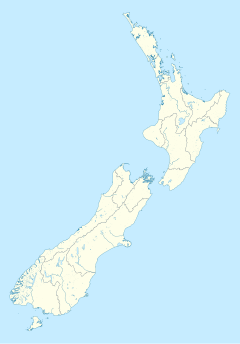Farewell Spit


Farewell Spit is a narrow sand spit at the northern end of the Golden Bay, South Island of New Zealand. Known to the Māori as Tuhuroa, it runs eastwards from Cape Farewell, the island's northernmost point. It is located about 50 kilometres north of Takaka and 20 kilometres from Collingwood.
It forms the northern side of Golden Bay and is the longest sandspit in New Zealand, stretching for about 26 km above sea level and another 6 km underwater. The spit runs in from west to east, and is made from fine golden sand - as Cape Farewell to the west of the spit is mostly composed of late Cretaceous quartz sandstones, i.e. silica but with traces of other heavy minerals, garnet, ilmenite, magnetite and pyroxene. The erosion of the cliffs into fine sand carried on the sea currents creates Farewell spit further east.[1]
The northern side of the dunes are steeper and unstable being constantly exposed to the prevailing winds which average over 25 km/h. The southern side, that which faces Golden Bay is more stable and largely covered with vegetation. The tide here can recede as much as seven kilometres exposing some 80 square kilometres of mud flats; a rich feeding ground for the many sea birds in the area but also a trap for the frequently stranded whales.[citation needed]
Human use

Abel Tasman in 1642 was the first European to see the spit, calling it Sand Duining Hoeck. Captain James Cook was the next European visitor in 1770,[1] showing Farewell Spit as a broad peninsula on his maps. He named close by Cape Farewell, and the name stuck, with early European settlers originally calling the sandbanks 'Cape Farewell Spit' before it was shortened to its present name. It was the last land he sighted after leaving New Zealand for Australia at the end of his first voyage.[2]
The lighthouse at the end of the spit was first lit in 1870. The last lighthouse keeper left in 1984 when it became automatic.
The Spit is administered by the New Zealand Department of Conservation as a sea bird and wild life reserve. Apart from a small area at the base of the Spit it is closed to the public except through organised tours.
Tours include the opportunity to jump off a sand dune, a visit to the lighthouse and the gannet colony. The south side of Farewell Spit is home to many thousands of sea birds; it also the site of frequent whale strandings mainly by Long-Finned Pilot Whales. The northern side is bounded by the Tasman Sea.
Shipwrecks
The Queen Bee ran aground off Farewell Spit in 1877[3] and the SS Port Kembla sunk by a mine 17 km off the spit in 1917.
Whale stranding
Whale standings have been a common occurrence throughout history on Farewell Spit. On 15 November 2012, a pod of pilot whales stranded themselves on the spit, around two kilometres north-east from the Spit Cafe. Eleven were found dead on the first day. The spit has claimed around 680 Whales since records began. In January 2014 several whales stranded and re-stranded. This included a pod of 50 pilot whales, many of whom died from stress or needed to be euthanised despite several attempts to refloat them.[4] In February 2015, pilot whales were found stranded on Farewell Spit.[5]
Gallery
-
A view from a Qantas flight
-
A panorama view from the beach near Puponga
-
Fossil Point
-
A estuary nearby Fossil Point
-
A beach along Cape Farewell
-
A view towards mud flats
References
- ^ a b Farewell Spit and Cape Farewell (from Te Ara Encyclopedia of New Zealand)
- ^ "Collingwood Travel Guide". Jasons Travel Media.
- ^ 'Wreck of the Queen Bee, from London', pg 2, Nelson Evening Mail, 8 August 1877
- ^ "Whales stranded on Farewell Spit". 3 News NZ. 15 November 2012.
- ^ "Nearly 200 Whales Stranded On New Zealand Beach". The Huffington Post. 13 February 2015. Retrieved 14 February 2015.
{{cite web}}: CS1 maint: date and year (link)






